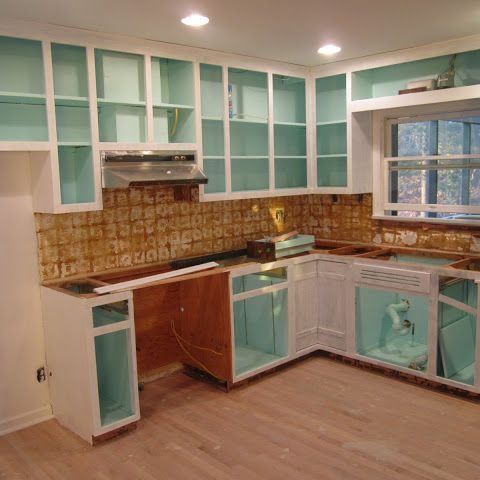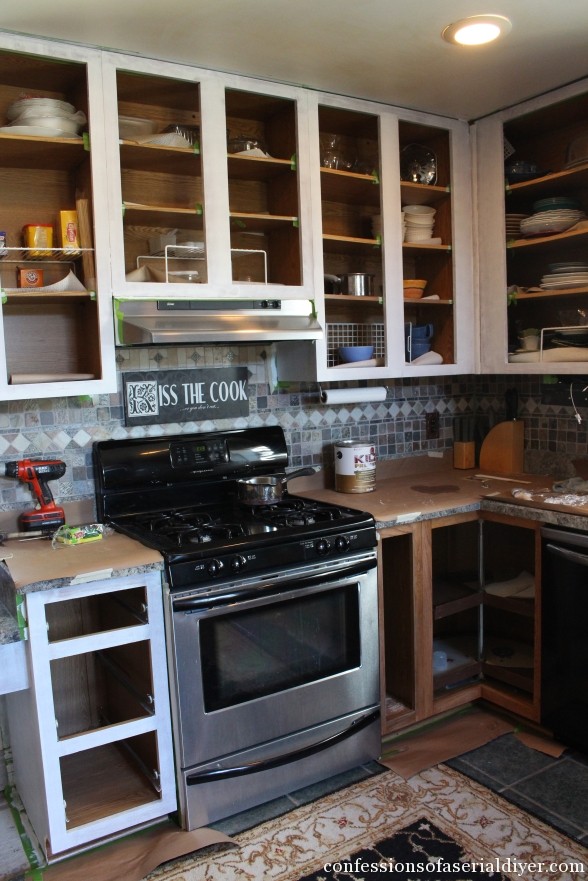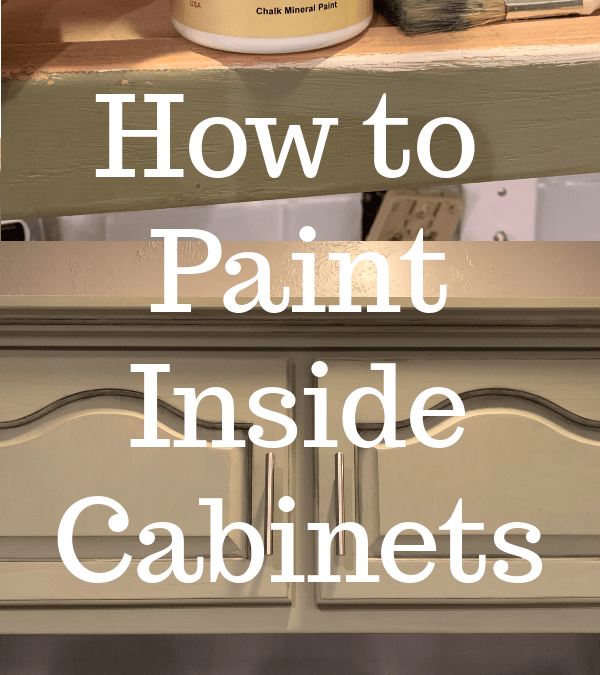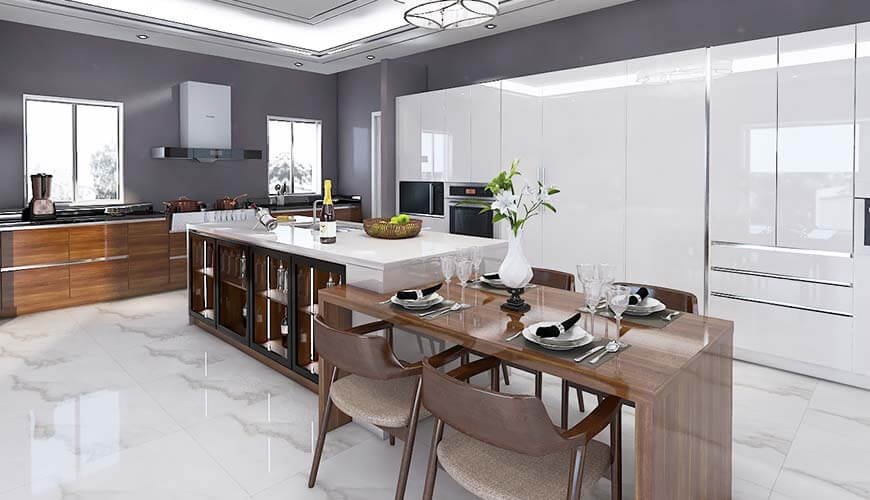Yes, it is safe to paint inside kitchen cabinets. Proper preparation and using the right materials ensure safety and durability.
Painting the interiors of kitchen cabinets can refresh and modernize your kitchen. Choose non-toxic, durable paints designed for kitchen use. Proper surface preparation, like cleaning and sanding, is crucial for good adhesion. Always work in a well-ventilated area to avoid inhaling fumes.
Using a primer before painting can enhance the final finish and longevity. Opt for a semi-gloss or high-gloss paint for easier cleaning and better resistance to moisture. By following these steps, you can achieve a professional-looking result that revitalizes your kitchen space.

Credit: letspaintfurniture.com
Table of Contents
ToggleBenefits Of Painting Kitchen Cabinets
Painting your kitchen cabinets can offer many advantages. It can transform your kitchen without a full renovation. This section will explore two main benefits: aesthetic appeal and increased home value.
Aesthetic Appeal
One major benefit is the enhanced aesthetic appeal. Fresh paint can make cabinets look new. It allows you to choose colors that match your style. Popular choices include white, gray, and blue. These colors can make the kitchen feel modern and clean. You can also opt for bold colors to make a statement. The choice of paint can set the kitchen’s mood. It can make the space feel cozy or vibrant.
Increased Home Value
Painting kitchen cabinets can increase home value. Updated kitchens often attract buyers. A modern-looking kitchen can make a big difference. Fresh paint can make the space look well-maintained. This can be a good selling point. Minor updates like painting can offer a high return on investment. It’s a cost-effective way to boost your home’s market value.

Credit: www.pinterest.com
Choosing The Right Paint
Choosing the right paint is crucial for painting inside kitchen cabinets. The paint must be safe, durable, and suitable for kitchen environments. This section will guide you through the types of paint and paint finishes ideal for this project.
Types Of Paint
Various types of paint are available for kitchen cabinets. Selecting the right one ensures a lasting and beautiful finish. Below are the most suitable options:
- Latex Paint: Easy to clean, low odor, and fast drying. It is water-based and safe for kitchen use.
- Oil-Based Paint: Provides a smooth, durable finish. It takes longer to dry and has a stronger odor, but it is highly resistant to stains.
- Chalk Paint: Gives a vintage, matte look. It requires a wax finish to seal and protect the surface.
Paint Finishes
The finish of the paint affects the look and durability of your cabinets. Choose a finish that matches your kitchen style and usage needs. Here are the common options:
| Finish Type | Characteristics | Best Use |
|---|---|---|
| Matte | Non-reflective, hides imperfections, less durable | Low-traffic areas inside cabinets |
| Satin | Slight sheen, more durable than matte, easy to clean | General kitchen cabinets |
| Semi-Gloss | High sheen, very durable, easy to clean | High-traffic kitchen areas |
| Gloss | Very shiny, highlights imperfections, extremely durable | Cabinet doors and exteriors |
Preparation Steps
Before painting inside kitchen cabinets, proper preparation is crucial. This ensures a smooth, lasting finish. Follow these essential steps for a successful project.
Cleaning Cabinets
Begin by thoroughly cleaning the cabinets. Remove all items from the cabinets. Use a vacuum to remove loose debris. Wipe down all surfaces with a damp cloth. A mixture of warm water and mild dish soap works well. For stubborn grease, use a degreaser. Ensure all residues are removed. Allow the cabinets to dry completely before moving to the next step.
Sanding Surfaces
Sanding the surfaces is essential for paint adhesion. Use medium-grit sandpaper to scuff the surfaces. This helps the primer and paint stick better. Sand in the direction of the wood grain. Avoid applying too much pressure to prevent damage. After sanding, use a tack cloth to remove dust. This ensures a clean, smooth surface ready for priming.
| Step | Action | Tools Needed |
|---|---|---|
| Cleaning | Remove debris and wipe surfaces | Vacuum, damp cloth, dish soap, degreaser |
| Sanding | Scuff surfaces for better adhesion | Medium-grit sandpaper, tack cloth |
Follow these preparation steps for a professional-looking finish inside your kitchen cabinets.

Credit: www.confessionsofaserialdiyer.com
Safety Precautions
Painting inside kitchen cabinets requires attention to safety. You need to follow certain precautions to ensure a smooth and safe painting process. This section will cover essential steps to keep you and your home safe.
Ventilation
Proper ventilation is crucial when painting inside kitchen cabinets. Open all windows and doors to allow fresh air to circulate. Use fans to help disperse paint fumes. If your kitchen has an exhaust fan, turn it on to remove harmful fumes. Fresh air can prevent headaches and nausea.
Protective Gear
Wearing the right protective gear is vital for safety. Use a mask to avoid inhaling paint fumes. Gloves protect your hands from paint and chemicals. Wear old clothes that you don’t mind getting dirty. Safety goggles protect your eyes from paint splatters.
| Item | Purpose |
|---|---|
| Mask | Prevents inhaling fumes |
| Gloves | Protects hands |
| Safety Goggles | Protects eyes |
| Old Clothes | Prevents paint stains |
Remember these safety tips for a safer painting experience.
Tools And Materials Needed
Painting inside kitchen cabinets can breathe new life into your kitchen. To ensure the job is done right, you’ll need the right tools and materials. Below is a comprehensive list of the essentials you’ll require for this project. Getting these items ready beforehand will make the process smoother and more enjoyable.
Brushes And Rollers
Having the right brushes and rollers is crucial for achieving a smooth finish. Use a small, angled brush for corners and edges. A foam roller works well for larger surfaces inside the cabinets. Make sure to use high-quality brushes and rollers to avoid streaks and uneven layers.
| Tool | Purpose |
|---|---|
| Angled Brush | For corners and edges |
| Foam Roller | For large flat surfaces |
| High-Quality Brushes | Ensure a smooth finish |
Drop Cloths And Tape
Protecting your kitchen surfaces is essential. Use drop cloths to cover countertops, floors, and appliances. These will catch any drips or spills. Painter’s tape is also necessary. It helps to create clean lines and protects the edges of your cabinets. Ensure all surfaces not being painted are well-covered.
- Drop Cloths: Protect floors and countertops
- Painter’s Tape: For clean lines and edge protection
These tools and materials will help you paint inside your kitchen cabinets efficiently. Remember to prepare your workspace well to avoid any mess.
Painting Techniques
Painting the inside of your kitchen cabinets can be a game-changer. The right painting techniques ensure a smooth, long-lasting finish. Let’s explore the best methods for this task.
Brush Vs. Spray
Choosing the right tool is essential. Both brushes and sprays have their pros and cons.
| Method | Pros | Cons |
|---|---|---|
| Brush |
|
|
| Spray |
|
|
Brushing is best for small cabinets and detailed areas. Spraying is great for larger surfaces and a sleek finish. Choose based on your needs and budget.
Multiple Coats
Applying multiple coats ensures durability and a smooth finish. Follow these steps for best results:
- Clean the surface thoroughly before painting.
- Apply a primer to improve adhesion.
- Let the primer dry completely.
- Apply the first coat of paint evenly.
- Allow the first coat to dry.
- Sand lightly for a smoother finish.
- Apply a second coat for better coverage.
- Check for any missed spots and touch up as needed.
Using multiple coats of paint provides a professional look. It also enhances the longevity of your kitchen cabinets.
Drying And Curing Time
Painting inside kitchen cabinets can revamp their look. But understanding the drying and curing time is crucial. It’s essential for achieving a durable finish.
Optimal Conditions
Optimal conditions ensure your paint dries properly. Here are key factors:
- Temperature: Keep it between 50°F and 85°F.
- Humidity: Maintain it below 50%.
- Ventilation: Ensure good air circulation.
Control these factors for the best results. Use fans or dehumidifiers if needed.
Avoiding Common Mistakes
Many make mistakes during the drying and curing process. Avoid these to ensure a smooth finish:
- Rushing: Allow each coat to dry fully. This usually takes 24 hours.
- Thick Coats: Apply thin layers of paint. Thick coats lead to uneven drying.
- Skipping Primer: Always use a primer. It helps the paint adhere better.
By following these tips, your painted cabinets will look great and last longer.
Maintaining Painted Cabinets
Painted kitchen cabinets can make your kitchen look bright and fresh. But to keep them looking new, proper maintenance is crucial. Here are some tips and tricks to help you maintain your painted cabinets.
Cleaning Tips
Regular cleaning is essential to maintain the shine of painted cabinets. Use a soft cloth and mild detergent to wipe down the surfaces. Avoid using abrasive cleaners. They can scratch the paint and make it look dull.
Follow these steps to clean painted cabinets effectively:
- Mix a small amount of mild detergent with warm water.
- Dip a soft cloth into the solution and wring out the excess water.
- Wipe the cabinets gently, focusing on any greasy spots.
- Rinse the cloth with clean water and wipe the cabinets again to remove any soap residue.
- Dry the cabinets with a clean, dry cloth.
Touch-up Strategies
Even with careful maintenance, painted cabinets can get chipped or scratched. Touching up these areas can help keep the cabinets looking new. Here’s how you can do it:
- Keep extra paint on hand for touch-ups.
- Use a small brush for precise application.
- Clean the area before applying touch-up paint.
- Apply the paint in thin layers to match the original finish.
- Allow each layer to dry completely before applying the next one.
By following these simple steps, you can maintain the beauty of your painted kitchen cabinets and ensure they last for years.
Frequently Asked Questions
Is It Safe To Paint Inside Cabinets?
Yes, it is safe if you use non-toxic, food-safe paint.
What Paint Is Best For Kitchen Cabinets?
Use water-based, non-toxic, low-VOC paint for kitchen cabinets.
How To Prepare Cabinets For Painting?
Clean thoroughly, sand lightly, and apply a primer for best results.
Do I Need To Remove Cabinet Doors?
Removing doors makes painting easier and provides a smoother finish.
Can I Use Regular Wall Paint?
No, use paint specifically designed for cabinets or furniture.
How Long Does Cabinet Paint Take To Dry?
Most cabinet paints dry within 24 hours, but full curing takes longer.
Should I Use A Primer Before Painting?
Yes, primer ensures better paint adhesion and longer-lasting results.
How To Avoid Brush Marks When Painting?
Use a high-quality brush or roller and apply thin, even coats.
Is Ventilation Necessary While Painting Cabinets?
Yes, proper ventilation is crucial to avoid inhaling fumes.
Can I Paint Over Old Paint?
Yes, but clean and sand the surface for better adhesion.
Conclusion
Painting inside kitchen cabinets can be safe and rewarding with proper preparation. Ensure proper ventilation and use non-toxic paint. Always follow safety guidelines for the best results. A fresh coat of paint can transform your kitchen, making it look new and inviting.
Happy painting!


